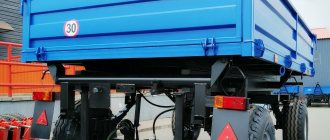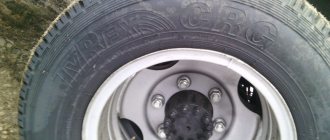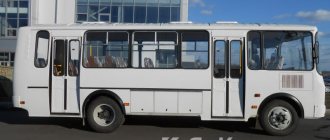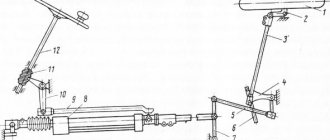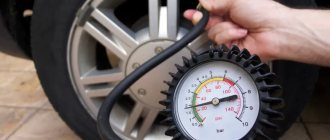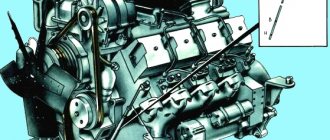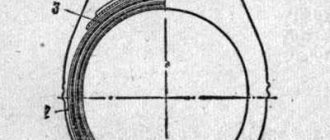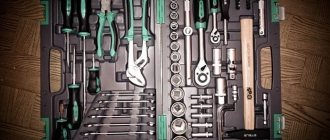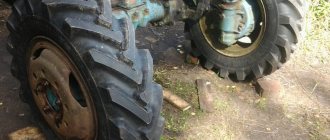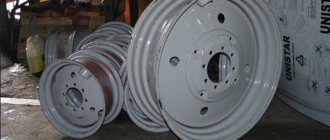Tires for tractors are selected based on operating conditions. Tractors from the Minsk Tractor Plant (MTZ) are universal and are used very widely: when clearing snow on the streets, plowing fields and harvesting, etc. Accordingly, there is no universal version of “rubber” for them. It all depends on how exactly the equipment will be used: on what soil, in what speed mode, etc. The model also plays a role - it is obvious that a heavy tractor needs larger and more durable tires than a compact minivan, and the pressure is MTZ 82 tires will be different than in the inner tubes of a forestry tractor type L82.2. Kits for the front and rear axles are selected separately.
Tire pressure MTZ-82
| Kind of work | Rear tires | Front tires |
| General types of work | 1,4+0,1 | 1,4+0,1 |
| For working on soft soils and plowing | 1,0+0,1 | 1,4+0,1 |
| For working with heavy agricultural equipment | 1,6+0,1 | 2,5+0,1 |
Tire load standards for selecting operating modes at different internal pressures
Calculation of pressure of front and rear wheels MTZ
Every tractor driver should be able to choose the correct tire pressure on MTZ. It is not recommended to constantly operate equipment at the same pressure value, even if it is within the permissible range. You need to select the pressure of the front and rear wheels depending on:
- tractor models;
- tire size and brand;
- season;
- soil characteristics;
- work performed;
- loads.
Let's figure out how to calculate what pressure should be in the wheels of the MTZ tractor in a specific situation.
Adjustment of wheel pressure depending on external factors
Let's consider the main situations in which it is necessary to adjust the pressure in the front and rear wheels of the MTZ. Tire pressure needs to be changed depending on:
- Loads.
The general rule is this: the higher the pressure of the MTZ wheels, the greater the load they can withstand. Tire inflation needs to be adjusted depending on the work being performed. For example, if the tractor is equipped with a loaded bunker, then the load on the front wheels increases - the pressure in them needs to be increased. If, for example, a heavy plow is mounted on an MTZ 80 or 82, then you need to increase the pressure in the rear wheels.
What pressure should I set in the rear wheels of the MTZ when operating under load? It is necessary to clarify the permissible tire pressure range in the operating manual and set it to the maximum level. It is not recommended to overinflate wheels above the permissible range.
When operating under load, the pressure of the front wheels of the MTZ 80 can reach 2-2.5 kgf/cm2, the pressure of the front wheels of the MTZ 82 and 82.1 – 2.5 kgf/cm2. In atmospheres this is 1.9-2.4 for MTZ 80 and 2.4 for MTZ 82. The pressure in MTZ 80 and 82 tires in atmospheres in the rear wheels when working under load must be increased to 1.55 atm.
- Movement speeds.
Tractor speed is rarely taken into account when determining operational parameters, since in most situations machines do not reach speeds exceeding 20-40 km/h. However, sometimes you need to travel a considerable distance to your place of work, and the speed in transport mode will be higher. In this case, the pressure in the MTZ wheels needs to be adjusted.
The general rule is this: the higher the speed of the tractor, the more the tires should be inflated and vice versa.
Let's consider the dependence of wheel pressure on the maximum MTZ load and driving speed using the example of Mitas AC 85 520/85R42 tires. At a tire pressure of 1 atmosphere, the maximum speed is 50 km/h, and the maximum load is 3.3 tons. If you reduce the speed to 30 km/h, then at the same tire pressure the maximum load will increase, it will be 3.53 m If you inflate the tractor wheels to a pressure of 1.4 atmospheres, then the maximum load will increase in all speed ranges: up to 3.84 tons at 50 km/h, 4.1 tons up to 30 km/h, 4.99 tons at 10 km /h.
| Travel speed no more than 16 km/h | You can increase the load on the drive tires by 20% without changing the pressure |
| Travel speed no more than 8 km/h | You can increase the load on the tires of the drive wheels by 30% by increasing the pressure by 0.3 kgf/cm2 (0.29 atmospheres) |
| Travel speed no more than 16 km/h | You can increase the load on the tires of non-driving wheels by 35% |
- Road surface.
It is imperative to adjust the pressure of the front and rear wheels of MTZ 80, 82 and other tractors depending on the soil:
- for asphalt and other hard surfaces - increase the pressure;
- for soft soils - the pressure is reduced to the minimum permissible (for most modern tires, the minimum pressure of MTZ wheels in atmospheres on the rear and front tires is 0.6-1 atm at speeds up to 30 km/h).
- Temperatures.
Is it necessary to change the pressure in MTZ wheels depending on the time of year? Experts have different opinions on this matter, but most still recommend slightly adjusting tire inflation. In summer, the tire pressure of MTZ 80, 82, 1221 and others is set according to the optimal values given by tire manufacturers. In winter it should be reduced by 5-10%.
For example, if you constantly set the pressure in the wheels of the MTZ 80 tractor to 1.4 kgf/cm2 for the front tires, then in winter it is advisable to reduce it to 1.3 kgf/cm2.
You can be guided by the universal pressure values in the tires of the rear wheels of the MTZ 80, 82 and others tractors for all types of work. It is equal to:
- 1.4-1.5 kgf/cm2 (1.45 atm) for general work - when you don’t know what pressure to set in the MTZ 82 wheels, and there is no way to calculate the optimal indicators for specific tires, set it;
- 1-1.1 kgf/cm2 (1.05 atm) for soft, loose soils and during plowing;
- 1.6-1.7 kgf/cm2 (1.64 atm) when working with heavy attachments.
Pressure in the front wheels MTZ 80:
- 1.7-1.8 kgf/cm2 (1.74 atm) – universal mode;
- 1.7-1.8 kgf/cm2 (1.74 atm) – on soft soils;
- 2.5-2.6 kgf/cm2 (2.5 atm) – for tractors with attachments.
Front tire pressure MTZ 82:
- 1.4-1.5 kgf/cm2 (1.45 atm) – for general work;
- 1.4-1.5 kgf/cm2 (1.45 atm) – for soft soils and plowing;
- 2.5-2.6 kgf/cm2 (2.5 atm) – when working with heavy attachments.
But it is better in each case (for a specific tractor, tires and working conditions) to calculate to what pressure to inflate the front and rear wheels of the Belarusian. We'll tell you how to do this later.
An example of calculating the pressure on the rear wheels of MTZ 82 and 82.1 in atmospheres
Let's calculate what pressure should be in MTZ 82 tires on the rear wheels when installing 15.5R38 Belshina tires on a tractor. The weight of the tractor before aggregation is 3.9 tons, the load is distributed on the front and rear axles in a ratio of 40:60. Thus, the base load on the rear wheel is 3.9 * 0.6 * 0.5 = 1.17 tons.
If the tractor was mounted with a seeder (or any other attachment) weighing 1 ton, then the additional load on one wheel will be 0.5 tons. The final load on the rear wheel of the MTZ 82 tractor is calculated as follows: 1.17 + 0.5 = 1.67 tons .
For rear wheel tires 15.5R38 Belshina, pressure, permissible load and maximum speed are distributed as follows.
| Maximum load (t) at driving speed (km/h) | ||||||
| Pressure, kgf/cm2 | Pressure, atmosphere | the tractor is standing | 20 km/h | 30 km/h | 40 km/h | 50 km/h |
| 0,8 | 0,77 | 2,84 | 1,75 | 1,52 | 1,42 | 1,29 |
| 1 | 0,98 | 3,24 | 1,99 | 1,74 | 1,62 | 1,48 |
| 1,2 | 1,16 | 3,62 | 2,23 | 1,94 | 1,81 | 1,65 |
| 1,4 | 1,35 | 3,95 | 2,43 | 2,12 | 1,98 | 1,79 |
| 1,6 | 1,45 | 4,24 | 2,61 | 2,27 | 2,12 | 1,93 |
To calculate the pressure in MTZ tires on the rear and front wheels in atmospheres, knowing its value in kgf/cm2, you need to multiply the known value by 0.968.
With a minimum pressure in tires MTZ 82 and 82.1 in atmospheres on the rear wheels of 0.77 (0.8 kgf/cm2), the tractor with the seeder can move at a speed of no more than 20 km/h. By inflating the tires of the rear wheels of the tractor to a maximum pressure of 1.45 atmospheres (1.6 kgf/cm2), you can drive at any speed on hard and asphalt roads. On soft soils, it is better to reduce the pressure to 0.9-1.35 atmospheres; besides, the speed on such surfaces will still not be higher than 20-30 km/h.
The principle of calculating what pressure should be in the rear and front wheels of MTZ 80, 82, 82.1, 1221 and other tractors is the same. You need to know the weight of the tractor before aggregation, the weight of the attachments, the load distribution along the axles (almost always 40/60).
Tables with the distribution of tire pressure, load capacity and driving speed can be found in the tire manufacturer's manuals.
What pressure should be in the wheels of a MTZ tractor: reference table
We recommend that you always calculate what pressure should be in the tractor wheels for a specific situation. But if this is not possible or you want to check the resulting values, use the following table. It offers universal indicators of tire pressure values for different MTZ tractors when operating without load and under load (with a fork, brush and other attachments).
| Tractor MTZ | Tire type | No load, front/rear | Loaded, front/rear | ||
| MTZ 80 | front — 9.0-20/rear — 15.5R38 | 0,8 | 1,4 | 1,4 | 2,5 |
| MTZ 80.1 | front — 9.0-20/rear — 15.5R38 | 0,8 | 1,4 | 1,4 | 2,5 |
| MTZ 80L | front — 9.0-20/rear — 15.5R38 | 0,8 | 1,4 | 1,4 | 2,5 |
| MTZ 82 | front — 9.0-20/rear — 15.5R38 | 0,8 | 1,4 | 1,4 | 2,5 |
| MTZ 82.1 | front — 9.0-20/rear — 15.5R38 | 0,8 | 1,4 | 1,4 | 2,5 |
| MTZ 82L | front — 9.0-20/rear — 15.5R38 | 0,8 | 1,4 | 1,4 | 2,5 |
| MTZ-100 | front — 9-20/rear — 16 | 1 | 1,4 | 1,1 | 2,4 |
| MTZ-1221 | front — 420/70R24, rear — 18.4 R38 | 1,5 | 1,8 | 1,58 | 3,06 |
Pressure in MTZ 80 and 82 wheels when operating under load: reference table
To calculate what pressure should be in the tires of the front and rear wheels of the MTZ 80 and 82 tractor when working with a load (kon, brush, etc.), use the following table.
| Attachments | Hitch brand | Pressure in the front wheels of MTZ-80, kgf/cm2 | Pressure in the front wheels of MTZ-82, kgf/cm2 | Pressure in rear tires MTZ 80 and 82, kgf/cm2 |
| Six-row corn seeder | SKNK-6 | 1,7 | 1,4 | 1,4 |
| Eight-row corn seeder | SKNK-8 | 1,7 | 1,4 | 1,6 |
| Inter-row cultivator | KRN-4.2 | 1,7 | 1,4 | 1,4 |
| KRN-5.6 | 1,7 | 1,4 | 1,6 | |
| Feeder-sprayer | POU | 2,3 | 2,5 | 1,3 |
| Transplanter hangers | SKNB-4A, SKN-6A | 2,5 | 2,5 | 1,4 |
| Trailed, carriage-free high-speed header | ZhRS-4.9A | 1,7 | 1,4 | 1 |
| Mounted double-bar mower | KDP-4 | 2 | 2 | 1 |
| Trailed mower with chopper | KIR-1.5 | 1,7 | 1,4 | 1 |
| Semi-mounted mower with chopper | KIK-1.4 | 1,7 | 1,4 | 1 |
| Trailed harvesters | Khersonets-7, KS-2.6, KS-1.8 | 1,7 | 1,4 | 1 |
If your attachment is not in this table, the pressure in the MTZ tires of the front and rear wheels can be calculated individually, knowing the weight and location of the machine.
Permissible loads at different pressures in the wheels of the MTZ tractor: reference table
For calculations, you may also need information on load standards for tires of different MTZ tractors depending on the wheel pressure (in atmospheres).
| Tractor tire/pressure in atmospheres | 0,79 | 0,99 | 1,18 | 1,38 | 1,58 | 1,78 | 1,97 | 2,17 | 2,37 | 2,57 | 2,76 |
| 7.50-20 | — | — | — | 580 | 625 | 670 | 715 | 760 | 800 | 835 | 875 |
| 9.0-20 | 580 | 640 | 715 | 780 | 840 | 900 | 960 | 1020 | 1070 | 1120 | — |
| 11.2-20 | — | 765 | 850 | 930 | 1000 | 1080 | 1145 | — | — | — | — |
| 13.6-20 | 1020 | 1100 | 1200 | 1300 | 1400 | — | — | — | — | — | — |
| 11.2-24 | 785 | 895 | 995 | 1090 | 1180 | — | — | — | — | — | — |
| 360/70R24 | 1090 | 1180 | 1285 | 1400 | 1500 | — | — | — | — | — | — |
| 16.9-30 | 1535 | 1745 | 1945 | 2125 | 2300 | — | — | — | — | — | — |
| 18.4-30 | 1750 | 1975 | 2200 | 2425 | 2650 | 2800 | — | — | — | — | — |
| 18.4/78-30 (18.4L-30) | — | 2005 | 2225 | 2430 | — | — | — | — | — | — | — |
| 18.4-34 | 2020 | 2220 | 2410 | 2610 | 2800 | — | — | — | — | — | — |
| 15.5-38 | 1420 | 1620 | 1810 | 1945 | 2120 | — | — | — | — | — | — |
| 16.9-38 | 1700 | 1920 | 2140 | 2355 | 2575 | — | — | — | — | — | — |
| 9.5-42 | 710 | 810 | 910 | 990 | 1065 | 1145 | 1220 | — | — | — | — |
| 11.2-42 | 895 | 1020 | 1140 | 1240 | 1335 | 1435 | 1525 | 1620 | 1700 | — | — |
Types of wheels
To choose and buy tires correctly at MTZ, you should understand the design of tractor tires. They are made of the chamber type, that is, they have an inner tube and tires. The chamber holds the air and takes on most of the load. The tire protects the tube from friction and consists of the following elements:
- Frame - made of cord, especially durable rubberized fabric, laid on top of each other in several layers. It is the characteristics of the cord that determine the strength of the tire and its load-carrying capacity.
- The inner layer of soft rubber is called a breaker and acts as a shock absorber for impacts received by the tread.
- The tread is the outer layer of durable rubber formed on the carcass and is responsible for the tire's grip on the ground. The adhesion parameters depend on the shape and depth of the pattern formed by the lugs and depressions.
- Sidewalls are used to protect the side walls of the frame. The beads secure the tire to the wheel rim and also increase the rigidity of the beads due to wire rings inside.
The tractor has tube-type wheels
The performance qualities of “rubber” depend on each of these parameters separately and their balanced operation as a whole. Now let's look at the main criteria for classifying tires and their types.
Each tire is marked in millimeter or inch variants. The marking is deciphered as follows. Let's take for example 380/80R38 142A8 / 142B, where:
- 380 is the tire width in mm or inches;
- 80 - profile (height to width ratio). For tractors, reinforced full-profile tires with an index of 80–82 are usually used;
- R - radial cord (the most common manufacturing technology. Less common is “-” - diagonal);
- 38 - wheel (disk) diameter in inches, also known as the internal tire size;
- 142 — level of maximum permissible load on one wheel in kilograms.
Mechanical wheel locking on the MTZ-1221 tractor
In some cases, on the most inaccessible sections of roads, a classic rear-wheel drive or four-wheel drive tractor cannot cope with a thick layer of mud and return to its track.
However, this does not mean at all that the equipment will not be able to overcome such a section, since the driver just needs to change the mode - turn on the locking of the center differential and the brakes, which will force the wheels to rotate at the same time and the tractor driver will be able to pull the car out of almost any mud.
This locking system has the following fairly simple design and principle of operation:
- The locking itself is made in the form of two cams, each of which is securely fixed on the drives of standard gears of the device, on the inside of the shafts, which in turn have a special grinding of the end to ensure play of these cams and the couplings installed on them.
- These couplings are connected to a drive made in the form of a separate pedal and lever on one side and, accordingly, to a locking and turning device on the central shaft at the opposite end.
- So, if necessary, the operator simply presses the locking drive pedal, the clutch moves in the space allocated for it, entails a shaft and a locking device, which securely snaps onto the gear, preventing further freedom of rotation of each wheel axle separately.
- This lever with a pedal in the cabin has a spring and automatic reverse action and, if released, it will return to its original position, and the differential lock will be removed and the wheels will begin to rotate normally.
- For longer fixation of the locking lever for the MTZ-1221 tractor, there is a special stopper on the pedal, pressing which causes the clutch to remain in the locked position for a longer time.
You might be interested in this About Bear tires
Tractor tire rupture
Important!
Mechanical wheel locking, although simple to implement and reliable in operation, is difficult to operate and non-functional. Therefore, on modern models of Belarusian technology, a more advanced system is installed - a hydraulic locking drive, which is distinguished by the fact that force and a long arm are no longer required to activate the mechanism, since the traction force increases many times under the action of compressed oil in the piston. However, such a system can cause piston leakage when overloaded and longer and more expensive equipment repairs.
Basic selection and classification criteria
Tire sizes are marked in millimeter or inch. You need to pay attention to the height and width:
- The purpose of the tire, which is expressed primarily in the tread pattern. Standard tires on MTZ 82 have a herringbone pattern recommended for agricultural machinery. For construction and road equipment, a shallow “checker” is better suited, and for logging - large straight lugs. You should not choose cross-country ability “with a reserve” - this will affect both fuel consumption and the condition of the soil.
- Design. Today, most tires are made with radial cords. Diagonal and solid ones are less common. Radial tires perform well on asphalt and provide a more comfortable ride. This is the optimal solution for vehicles operating on the streets or often driven from site to site along asphalt highways. For tractors operated on the ground, cheaper bias-ply tires are quite suitable. For equipment operating on hard soils under heavy loads, you can consider the option of solid tires. They withstand significantly greater loads than pneumatic ones and cannot be punctured, but they do not absorb shock loads, which destroys the tractor's chassis.
- Speed indices are rarely significant for special equipment. Typically, “tires” for tractors have a speed index of 30-40 km/h. But for models that can reach high speeds and are often operated at high speeds, this figure will be significant.
Sizes and their selection
Typically, the MTZ 82 rear tires are 15.5R38 in size, and the front tires are 11.2-20. For each MTZ model, the manufacturer has established recommended tire sizes. The dimensions are selected according to the inner size of the tire; it must match the outer diameter of the rim. Otherwise, the owner has the right to choose between low- and high-profile tires, based on working conditions and financial capabilities.
Rear tires measuring 15.5-38 are distinguished by a reinforced breaker and radial placement of cord threads in the carcass. Tires whose carcass has a diagonal arrangement of the carcass cord threads form the plane of the tire profile with an angle of 50-54º, and tires with a radial design - their angle does not exceed 5º. The radial arrangement of the cords gives the tire better flexibility. Also, these tires improve the traction and grip qualities of the tractor, compact the soil and slip less, and have a longer tread wear resistance.
Operation and maintenance of MTZ 82 tractor tires
The technical condition of tires affects the traction and grip qualities of the tractor, its fuel consumption, cross-country ability and productivity. Thus, we can safely say that tires largely determine the productive and economical operation of a tractor. In addition, tires are expensive and wear-out components of the tractor, the price of which is about 12% of the cost of the tractor itself. During the entire service life of the tractor, tires are changed 3-4 times, so the cost of operating tires is approximately 20% of the total cost of operating the tractor.
The service life of a tire is affected not only by compliance with operating rules, but also by the conditions in which they are used: air humidity and temperature, road surface characteristics and soil properties. When using a tractor for field work, the service life of tires is about 6,000 hours, and when performing transport work they wear out much faster. On rocky soils and in mountainous areas, the tire service life is reduced by 25-35%, and on winter snow cover, on the contrary, it increases by 25-30%.
The front drive tires of the MTZ 82 wear out faster than the rear ones. This is explained by the fact that the rolling radius of the front tires is 1.7 times smaller than the rear tires. When traveling the same path, the front tires make more revolutions.
Tire pressure
Since the sizes and loads experienced by the rear and front tires of special equipment differ, the pressure in the tires varies accordingly. The recommended pressure for MTZ tractors is:
- 1.4+0.1 kgf/cm2 for general work;
- 1.0+0.1 in the rear and 1.4+0.1 in the front for soft soils and plowing;
- 1.6+0.1 in the rear and 2.5+0.1 in the front for heavy agricultural equipment.
These standards are developed taking into account the strength of tires.
When performing some types of work, a temporary deviation from the norm is acceptable (for example, if you lower the pressure, you can increase the cross-country ability), but constant operation in this mode will certainly lead to accelerated wear of the “rubber.”
To prevent rapid tire wear, it is recommended to adhere to the following rules:
- strictly observe the internal tire pressure standards, depending on the operating conditions and loads on the tractor;
- When driving at high speeds, check whether the tractor is pulling to the side. If it does, then stop the tractor and inflate the tire with lower pressure;
- try to avoid sudden braking that causes the wheels to skid, as well as prolonged wheel slipping;
- do not place the tractor on soil contaminated with petroleum products;
- check and adjust the front wheel alignment in a timely manner;
- disable the front axle on dry roads;
- Do not let the wheels wobble or wobble.
Wheel balancing
Wheels for special equipment do not require balancing. The problem of wheel runout is most often associated with problems in the crosspiece (less often in bearings) and wheel alignment problems.
It is worth noting the method that many use to improve the driving characteristics of the tractor . To do this, liquid is poured into the chambers - from plain water to special antifreeze. Cast iron weights are also used. These measures improve traction and make the ride smoother. However, they have nothing to do with wheel balancing.
